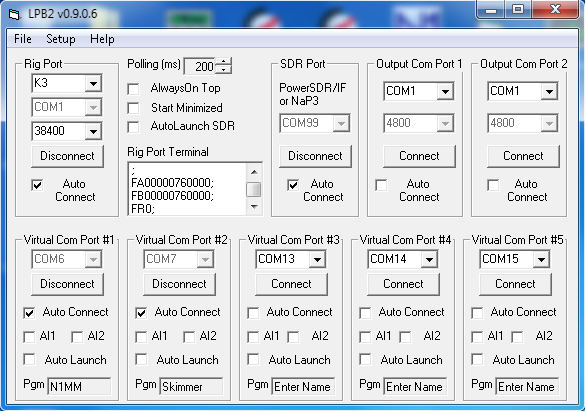Cw Skimmer Serial

CW Skimmer General. This implementation loads and connects SmartSDR to CW Skimmer without using a virtual serial port pair. Connection is accomplished using TCP/IP. The CW Software. CW Skimmer requires access to the serial port in order to set and get the frequency from the K2 or K3 - as does KComm. Download now the serial number for CW Skimmer 1.91. All serial numbers are genuine and you can find more results in our database for CW software. Updates are issued.
October 8th, 2016 The software now supports from. CW Skimmer simultaneously decodes all CW signals in the receiver passband - either 48, 96 or 192kHz.
As well as CW Skimmer, the interface also supports MAP65 albeit in a basic mode (below). Many thanks to Alex for the complimentary licence. CW Skimmer interfaces with this software via: • A virtual serial cable, and • A virtual audio cable (although the soundcard Mixer input can be used if available). Virtual Serial Cable This provides a connection between the two programs which is used for frequency control - CW Skimmer reads the frequency from the console and changes the console frequency as you use the ↑↓ button in CW Skimmer. Examples of virtual serial cable programs are: •, free for licenced amateurs only •, 14 day free trial •, free for 32-bit systems, •. Asbabun Nuzul Lengkap Pdf To Excel. Virtual Audio Cable CW Skimmer reads the IQ data from the console over the virtual audio cable at a bandwidth of 48, 96 or 192 kHz (48kHz is recommended).
Examples of virtual audio cables are: • VB Audio from, • Virtual Audio Cable from. Note: the interface uses a two-channel connection (I and Q), so the VAC settings must allow at least two channels (screenshot below). In the console program select More Options. In the View pane of the ribbon bar. Press the Select button to enable the options to be displayed. Make sure CW Skimmer is checked, then press OK. You will be prompted to restart the program.
When restarted the CW Skimmer option is available. Now press the CW Skimmer button to display the options. The options are: • Enable - when selected [X] the Serial port and Output device are opened. • Serial port - one end of the virtual serial cable (more information below). • Diagnostics - when enabled all serial port traffic is sent to the system debugger, see Diagnostics below. • Bandwidth - the data (IQ) bandwdith sent over the virtual audio cable. The recommended bandwidth is 48kHz, make sure the virtual audio cable is configured to support the selected value.
• Output device - the virtual audio cable (more information below). Virtual Serial Cable Here the is used. The virtual serial cable has been created with the first port COM10, the second port COM11.
COM10 will be used by the Console, COM11 by CW Skimmer. Virtual Audio Cable Here the software from is used. The default settings are used which permit a bandwidth of 48kHz. The device name in Windows is Line 1 (Virtual Audio Cable). Only use the cable definition for the data connection between the console and CW Skimmer, do not use it for other applications or to send audio from the console at the same. Note: the interface uses a two-channel connection, so the VAC settings must allow at least two channels (screenshot below).
CW Skimmer is configured to use: • Radio type SoftRock-IF • Sample Rate 48kHz • Audio Signal I/O Device: the virtual audio cable • CAT TS-2000 with the virtual serial cable In more detail Start CW Skimmer, from the View menu select Settings. • Radio: • Select Hardware Type SoftRock-IF, sample rate 48kHz. Download Football Manager 2009 Highly Compressed here.
• Audio: • Signal I/O Device select the same virtual audio cable selected in the console, • (Optional) Audio I/O Device select the device for audio playback. • CAT: • Press Configure to display the OmniRig settings, Select Radio 1 TS-2000, Radio 2 None. OmniRig These settings have been found to work well. Note in Rig1 the Port is part of the virtual serial cable, explained in the Console configuration. You do not want Rig2 defined so select NONE from the RigType dropdown.